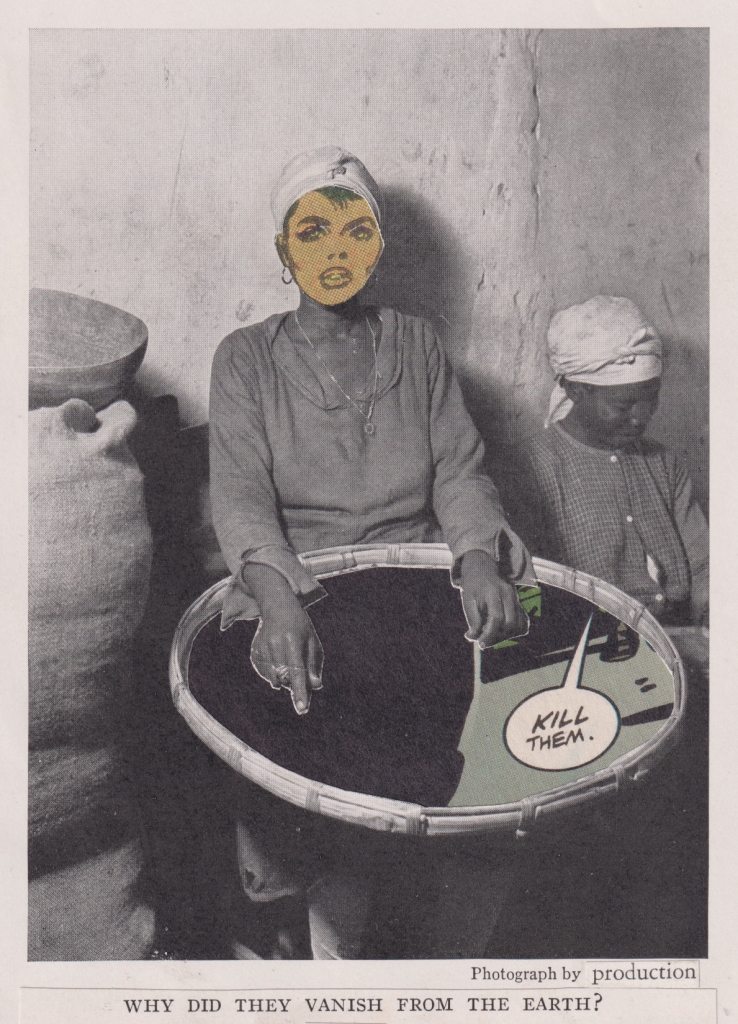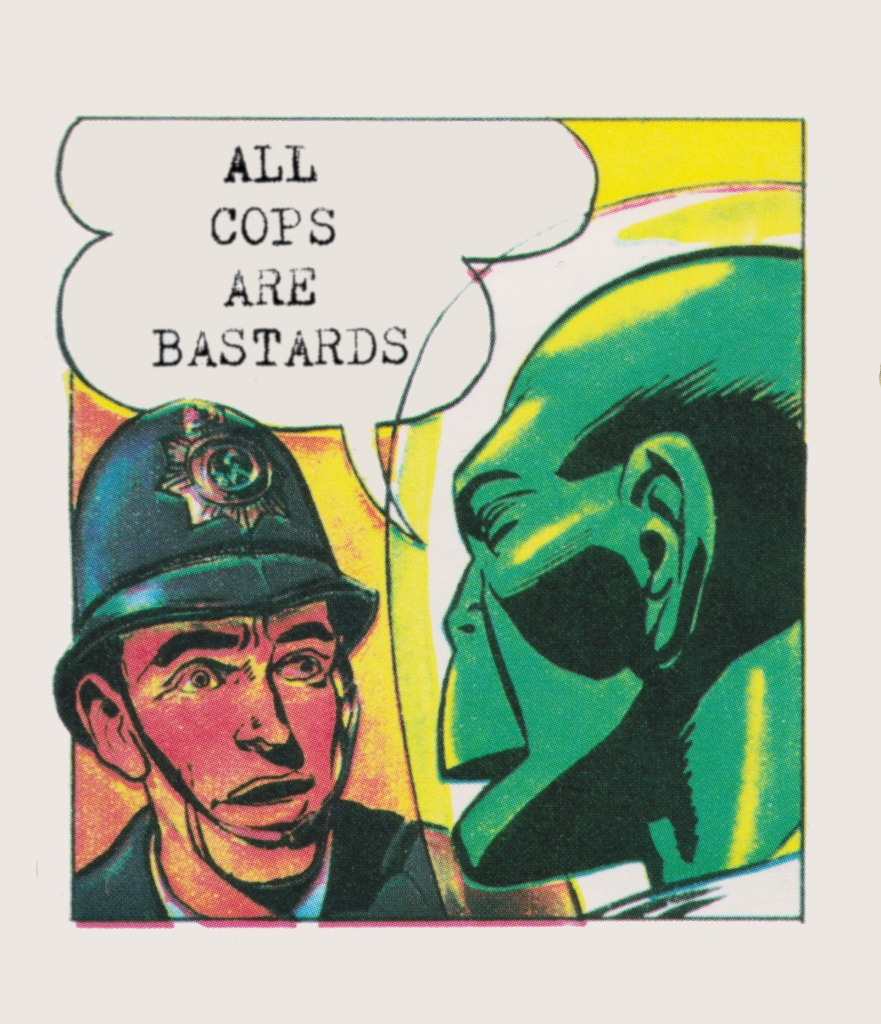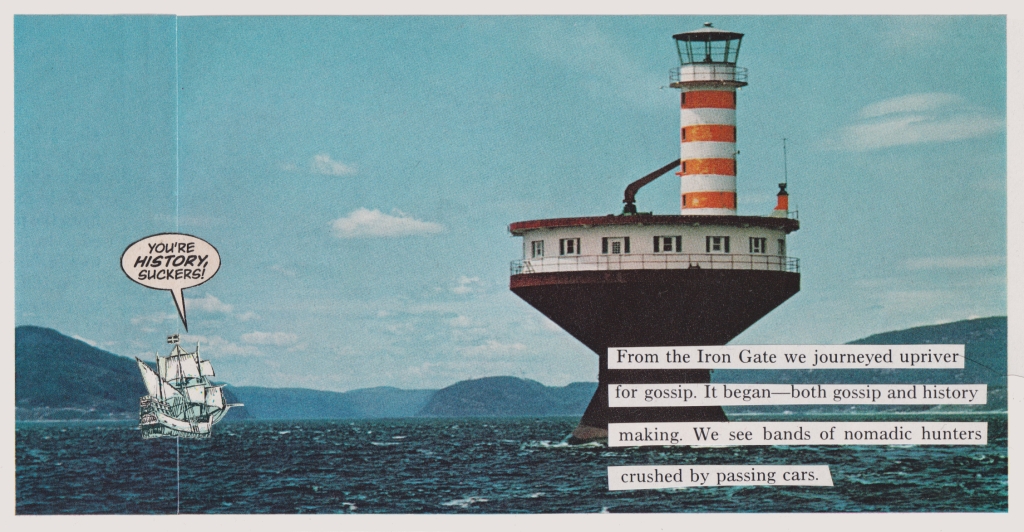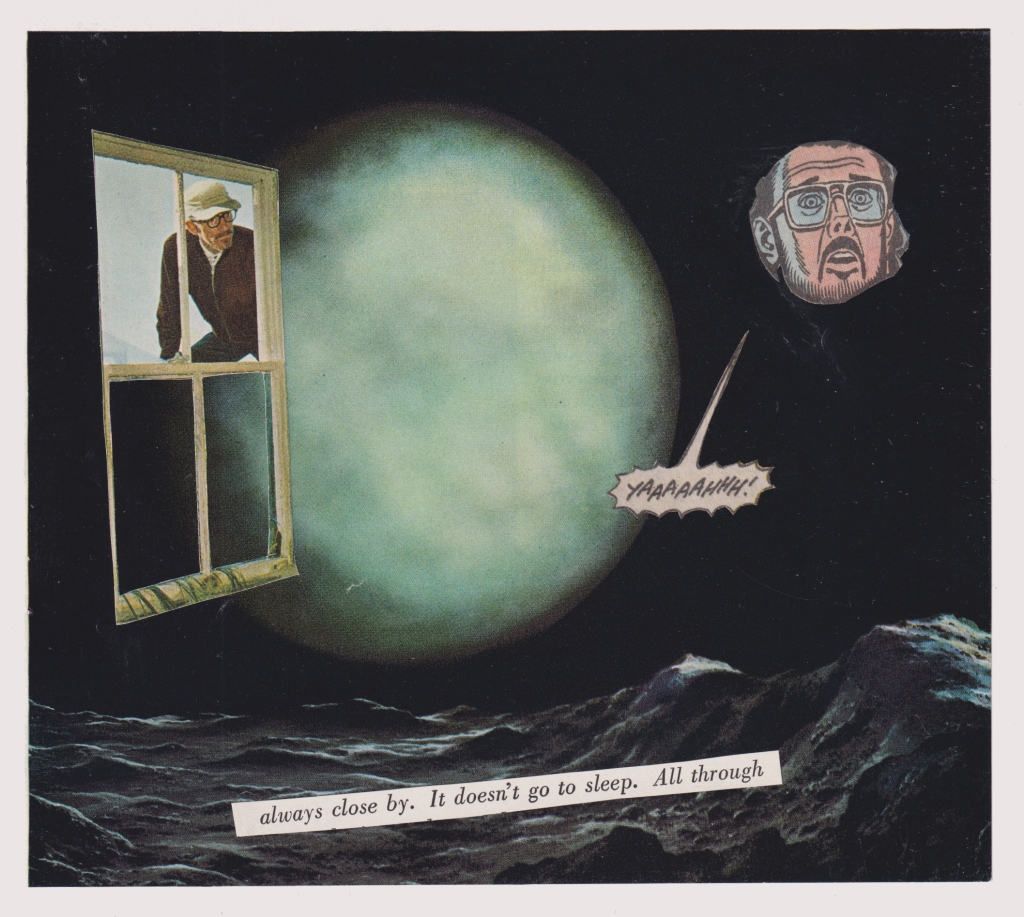
This has been another Collage Tuesday post. On Thursday.

This has been another Collage Tuesday post. On Thursday.

This has been another Collage Tuesday post. On Thursday.

Today’s collage was made courtesy of a game of Dixit last Friday night. The card used as the base for the collage, above, was taken from the original Dixit game. The prompt was ‘Thanks capitalism’. Even though no one guessed it, we all agreed that it was the most appropriate picture to go along with the prompt. After discussing it with the prompter, I scanned the card, found a thought balloon from a comic, scanned that, and then got out my trusty Hermes baby, typed up the prompt and then scanned that. Then, with all the elements swimming around in the electronic space of my computron I used the ever reliable Gimp program to being them together in the collage you now hold in your head.
(cue best sarcastic tone, or, at the very least, the most adequate)
“Thanks capitalism….”
This has been another Collage Tuesday post.

The above, and below (though not the middle…) were made for a friend’s birthday.

They were made amidst some other experiments in assembly line collage production–for example, here and here. Which may, or may not, explain why there are two versions here. Either that, or indecisiveness. Whatever the case, it is only ‘kill them’ that made its way into the physical-non-electronic-realm (as opposed to the physical-electronic-realm).
Caught up with some meditations and ruminations, there is the question of the person to whom the gift was made. I have here a fragment of something that may offer an explanation.

Io? you may well ask. The Jovian satellite, mythological nymph… or something else? This vilm may be of some help:
This has been another Collage Tuesday post. Plus extras.

What horrid place is this? An eye for a sun and a sun for an eye? And that unspeakable monstrosity heaving its slithering bulk into view from below? The steady flap of its tendrils blessedly extinguished by the attenuated planetary atmosphere…
The original is the somewhat more prosaic cover of Authentic Science Ficiton, no. 73 (September 1956).

Having seen the original, be in doubt that what I have presented is authentically inauthentic. Or is that inauthentically authentic science fiction? One or the other…
The title, though, where the hell does the title come from!? Wonder no more, dear reader, for all will be revealed.

Do you have the instructions habit?
Can one really stop the intellect forever?
And what exactly has agriculture ever done for you?
This has been another Collage Tuesday post.

POSSIBLE WORLDS (Epilogue Written Amid the Ruins)
He was a young man, here to cut up a National Geographic,
to come to another destination, maybe the double life of avant-garde earth stations, and shopping
anywhere, any time.
“How can it be solved?”
Now, because this world, this world of electronic satellite communications
is a poor river,
a closed-loop of the monstrous, monotonous, across which
we move incessantly, cheeks with thorny sticks and charged with promise,
at least in part, the world’s greatest
you is crushed for industrial use,
what a way to go,
an ode to a stalk of the urban proletariat.
Born of Kings and Stars.
I made ‘Possible worlds’ in 2022. But my obsession with the image is longer lived, snaking all the way back to a day in the early 1980s when I found the National Geographic from which I stole the base image in a sleepy second hand bookstore in Hurstville, Sydney.
The image is from 1969. It represents the then stunning view of automation and what-not coming in the near future. I recall being somewhat fascinated and disappointed that the 1970s and 80s I grew up in bore only a passing resemblance to such images of a happy, technological future.
Jump forward a few decades and all that remains of that issue is the much cut-up and cut-out remnants. Indeed, this base image, which I had rescued from the bin and stuck together (it was originally a two page spread), was itself showing its age–or at least its wear. The left side is the result of my immaculate archiving.
The base image has been subtly altered. The poem, screed, etc., that accompanies it is composed of choice words and phrases taken from the abundant results of industrial cultural production. It is featured in a recent zine of poems I published in 2022: sexpoem. I will make a pdf available of this in a few days. But in the meantime, check out this review of said zine by Gerald Keaney.
The last two lines, “an ode to a stalk of the urban proletariat. Born of Kings and Stars” is as much about me as it is about you. We all find ourselves the unfortunate denizens of a proletarian age, in which capital, capitalism, the commodity-spectacle, what have you, has either made us over into the proles it needs to produce and consume , or–once ruined or rendered superfluous to capital’s needs–so much human material carelessly thrown onto the scrapheap. Perhaps a more sane future will realize the melancholic truth of this era: it is a proletarian age in which even stupid capitalists are reduced to mere appendages of powers they barely understand.
Perhaps one day we will build a suitably pathetic Statue For A Proletarian Age–not in commemoration, but only to recall the living nightmare that briefly and disastrously took hold before the dawn of a truly human society.
A world that still remains to be built.
This has been another Collage Tuesday post on Wednesday…

Back by popular demand–Collage Tuesdays.
Not Monday, not Wednesday, not Anyday. Just Tuesdays, no matter what day it is or where it is located.
‘The street’, above, was quickly constructed last Friday afternoon (I will leave it to the eagle eyed to spy out some of the source material). It became a long overdue gift to an old friend.
‘The street’ was rapidly followed by three other comic based collages. The results I turned into a collage zine that has already been printed and distributed.
Click on the cover image of the zine, below, or here, for a copy of the collage zine. Though laid out in A4 format, I recommend printing it as an A5 pamphlet.

See ya next chewsday…

This year past I lost interest in the primary focus of this blog as it was expressed at its founding (check out this somewhat elusive explanation). I found it hard to sustain much enthusiasm or fascination in the very many things that nonetheless fascinate me. In large part I was haunted by my own past and the lingering life and death of my mother. Mostly, I despaired for the earth and my fellow humans, we who have singularly failed to overturn the world of destructive self-interest and runaway commodity production, mass consumption and climate change.
Indeed, how can I avoid the simple fact that in my own small way, by way of this blog and its accoutrements—laptpos, phones, tablets, servers, power stations, factories, shopping malls, oil wells, refineries, ships and containers of all sorts—I have contributed to the global mess alongside all my species’ brothers and sisters. Nonetheless, and in the depths of this widespread natural and social alienation, amidst all the avatars of wage labour and mass consumption, equally awesome and boring in their extent and aspirations, the forces of true liberty, compassion, cooperation, and magnificent creation, continue to hold out against the titanic flood of this shit of our own making.

If not, then perhaps all is lost, at least for this most recent cycle of modern and so-called postmodern history.
Which is not to say that all the damned products of this society are without a value beyond their price—or lack thereof. Rather, it is to acknowledge the deadening effect of widespread commodification, and the consequent flattening of affect. Different things become valued for their monetary worth more than any sense of their unique, intrinsic value—whether useful or symbolic. And even those things that apparently escape such valuation come to resemble that most despicable of things, the commodity (and are, in any case, costly).
But in a world awash in commodities, all clamouring for your attention and hard-earned dollars, before being consigned to landfill or the far from bottomless oceans, is it any wonder that the sheer volume of words that circulate adopts the form and appearance of the commodity? The constant, nagging demands: read this, not that; or read this and that and this and… so on.
Not so long ago, in the late 1990s, naïve radicals believed the global internet would usher in an age of unprecedented freedom and rationality enabled by this widespread access to information. What we got instead was not just the already existent absurdities of capitalism, but rather these inanities and profound irrationalisms jacked up to the nth degree. Now, the non-stop dialogue monologue of capital and its avatars is almost inescapable. Meanwhile, the agents of market freedom continue to not only refine methods designed to exploit our social anxieties, but busily promote and profit new and even more insidious forms of despair and alienation. I’m looking at you, so-called social medias.
Holed up in our various sub-genres and ghettoes, we can imagine that we are escaping from all the noise and destruction that accompany the runaway climate change brought on by the twin furies of industrialism and consumerism. But as the ghettoes proliferate, and create their own markets and fifteen nanosecond stars, we find ourselves lost in the very labyrinth we sought to escape.
The results of production, cultural and otherwise, appear to me in fever dreams as an inverted cone in which the base, now pointing skyward (or futureward as the case may be) continues to expand at an alarming rate. Whether video games, cinema, high literature, or toxic sludge, we are drowning in a deluge that only seems to gather speed and volume as the years past. I sometimes wonder if the best course of action would be to shut up, stop writing, creating, producing, and adding to the piles of things bought and sold. There is so much stuff circulating today. Stop the online merry-go-round, I wanna get off…
One of the chief beneficiaries of contemporary irrationality and profit hungry madness is the resurgent fascism we see increasingly all around us. In my childhood in the 1970s and 80s, the thought that fascism would once again become a serious threat to human existence was an almost laughable proposition. The memory of the wars against fascism still lived at that time in the blood and sinews of the women and men who defeated Hitler and his ilk. Today, as the memory of the disasters of the 1930s and 40s recede from life and view, we once again must turn to the task at hand: not just the defeat of the fascists, and all the assorted deniers of the exploitation, oppression and destruction that grow daily, but rather the source of all this unnecessary misery—capitalism itself. Certainly, our words and actions tend to become lost in the hall of mirrors that is the modern commodity spectacle. But even capital is finding it harder to disguise the truth of what it confusedly names the freedom of the market.
So one more effort, comrades, because one day it will all be over…
Nonetheless, I cannot escape the sense that blogs, any blogs, my blog more pertinently, often reflect the worst aspects of the current historical moment. Blogs as personal expression in an ocean of self-promotion, all clamouring to be read. And yet what else can we do but get amongst it? After all, how else does one resist the onslaught, and imagine something beyond this present, awful conjuncture, other than by expressing possibilities, somehow, anyhow…
*
One final thing before turning to the matter at hand. Generally, I despise “best of” lists, particularly those that litter our eye lines, so much spam and clickbait holding out the promise that maybe this time, with just one more website, I will at last find something to fill the yawning chasm within. And yet I love “best of” lists too, seeking them out as a shorthand to knowledge, just as I occasionally proffer them as evidence of my own experience and good judgements.
Not one of my posts from 2023 make it onto the top five visits made to my blog over that year. Perhaps because I simply did not post many words, even though 2023 saw the most annual blog posts ever churned out by me. This year I posted mostly collages, with a few comments—some of which can be seen scattered around this post. The collages served mostly a therapeutic role. I did post some longer blog pieces, including No More Tomorrows: The Criticism of Science Fiction as Science Fiction (9th most “popular”) and Poetic City? (lucky 13th). The latter, I would like to think of as a Preface to a grander project, unitary urbanist in inspiration, that has both Canberra and science fiction in its sights.

Appropriately, the most “popular” post on my blog (again with the scare quotes to draw attention to the far from popular nature of my posts, whether as objects consumed or produced) can equally be considered as a part of this Preface-of-what-is-yet-to-come. In my review-cum-meditation upon Ballard’s short stories ‘Manhole 69’ & ‘The Concentration City’ (both 1957, the same year the Situationist International was founded), one detects concentrated all of my wishes and desire for Ballard to be the site of a situationist like entry by the stealth of science fiction into the everyday mass pop imaginary.
And the next four popular of my posts over 2023, you may wonder…
The five most:
2. Guy Debord’s Surrealism: an irrational revolution (originally posted: 2 July 2021)
3. Frederik Pohl’s mass consumer (1): The Midas Plague (posted: 11 January 2021)
4. Robert Silverberg Downward to the Earth (posted: 8 February 2022)
5. SF in the SI: science fiction, ideology and recuperation (posted: 9 August 2020)
These are all good posts, as far as it go. I was particularly taken by the one on Silverberg’s Downward to Earth on a reread recently. The last of these has been somewhat overtaken by my own research, now available in the shape of a recently published academic article: ‘Science Fiction and the Situationist International’ (check out the rest of the issue of the New Readings journal it was published in, here).

Sadly, some of my favourite posts failed to make the popularity cut. “Which ones?” I hear you clamour.
The post, What comes after SF (originally posted: 22 February 2022), I have a particular soft spot for. I have long been fascinated by the fact that something like SF rarely appears in SF literature. Additionally, l am equally intrigued by the idea that SF, like all things living or not, will one day be no more. Too often critics of SF write as if SF—once “discovered”, “invented”, whatever—is here for the duration. Such are the conceits of puny homo sapiens under present conditions. Such ruminations have led me even further, in perhaps an ill-advised attempt, to write SF criticism as if it was also (science) fiction. You can check this experiment, in the following post: No More Tomorrows: The Criticism of Science Fiction as Science Fiction. Indeed, ‘No More Tomorrows’, along with ‘What comes after SF’, most certainly make it onto my favourite top 5 posts of the sinister science…
What will 2024 bring? I’m hesitant to promise anything anymore, considering the very many promises that now linger around this blog and a few others. I’m hoping that this year will be personally more rewarding for me, as opposed to last. Nonetheless, I know that I will be facing some serious health issues this year that threaten to drag me down once again. And I haven’t even started on what this year holds for us in the realm of the geo-political-public-global-space, though I have intimated as much in my opening remarks.
Nihilists, cynics, and other ne’er-do-wells that reject the bland optimism of capitalism…
ONE MORE EFFORT IF YOU WANNA MAKE A REVOLUTION!

This is a photocopy of a collage that no longer exists in its original form–as far as I know. It appeared in a zine called Red, issue no. 2, sometime in 2001 in Canberra. The editors were called ‘spacefish’, a cosmically aquatic beastie that consisted of H. Catchpole and T.S. Ellis when it was assembling zines and such like. Someone has helpfully–or not, as the case may be–added the name of the collage’s author, above, though I of course deny any responsibility. It was antyphayes that done it.
I love the look that can be produced by photocopier’s of yore, not the hi-res fandango of the post-post-modern photocopier. Though I like that too, confusedly.
Down with the hi-res! Up with the rose!
This has been another Collage Tuesday post. From a forgotten Friday.
This has been another Collage Day post.

On a chilly, imaginary moon, there is something close by. It doesn’t go to sleep. All through… (message breaks off–editor).
Bonus collage for clarification:

This has been another Collage Tuesday post. From a future Thursday.